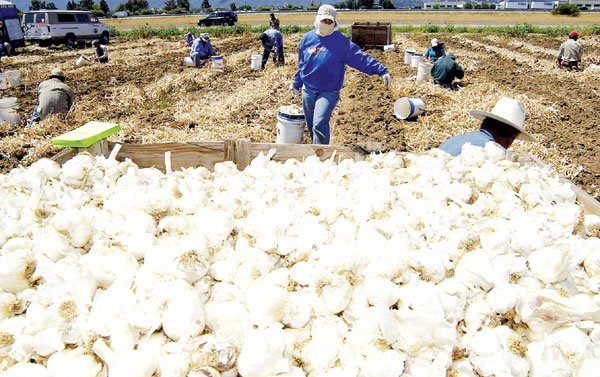Gilroy
– While driving through the city, residents and tourists alike
often find their attention captured by neatly groomed rows of
greenery, nestled in carpets of coffee-colored soil. Necks crane
and eyes squint as passers-by try to catch a swift glimpse of
Gilroy’s farms from their car windows.
Gilroy – While driving through the city, residents and tourists alike often find their attention captured by neatly groomed rows of greenery, nestled in carpets of coffee-colored soil. Necks crane and eyes squint as passers-by try to catch a swift glimpse of Gilroy’s farms from their car windows.
Miles later, continuing on their journeys, the thought arises: What was growing there, anyway?
More than 25 years ago, the California Farm Bureau organized a program encouraging farmers to place signs along the edges of their farms, announcing to the world what crops were being grown. Several farms and local service clubs participated in the program through the 1980s, said Bob Perkins, executive director of the Monterey County Farm Bureau.
“The theory behind that was to interest the non-farming public in what’s going on out there in the fields,” Perkins said. “It’s such a funny thing, because people drive by and see the crops, but they don’t relate that to the food that’s on their tables. People are naturally curious. They always speculate as to what grows there, but it’d be nice to know.”
While participation in the bureau’s program has dwindled since its establishment, Perkins said, a handful of individual farmers have continued to make use of the signs. But for vegetable farmers with alternating crops, common in Monterey and Santa Clara counties, switching the signs with each crop change might not be worth the effort. Such signs might be more viable for tree and vine farmers, whose crops remain constant through the year.
Some farmers would rather use the signs to promote awareness of local issues rather than crops, Perkins said, citing a recent campaign that supported subsidized water with signs reading “food grows where water flows.”
Dave Kranz, spokesperson for the California Farm Bureau, said that while the bureau isn’t actively pursuing reviving the sign program, farmers might want to consider the potential benefits of signs on their own.
“It used to be much more common,” Kranz said. “There’s always a benefit in helping people understand where their food comes from. We live in the number one agricultural state in the nation, and we directly benefit from proximity to food production. But people don’t always make that connection if they can’t see it.”
Kranz said crop identification signs fit right in with other efforts to inform the public about what they’re eating. Country of origin labels, for example, help people decipher imported foods from domestically produced foods. Signs could serve a similar purpose but in a more local sense, he said.
Signs also can be a valuable marketing tool for farmers who sell their produce at nearby stands, such as Brent Bonino of LJB Farms in San Martin. Bonino said the farm has used signs to advertise its for-sale produce for about 25 years.
“It helps draw people in and it gets their attention,” he said. “Our crops are seasonal, so we put the signs up in July and take them down in December. But every year, we put them up.”
Jenny Midtgaard Derry, executive director the Santa Clara County Farm Bureau, said developing an organized program for crop signs is something the bureau might consider in coming months. Because the county produces such a wide variety of crops, she said, signs might help engage people who generally aren’t agriculture savvy.
Juanita Mesa, a traveler, drove to Gilroy three weeks ago from Las Vegas. Several fields she saw while traveling through California did not have signs, piquing her curiosity.
“I definitely wondered what was out there. I think it’d be great to know,” she said. “You see all these huge fields, and they’re so neatly kept. It seems to me that the state of California is really proud of its agriculture, so you think they’d want to show it off a little more.”















